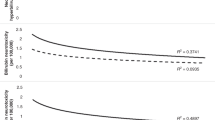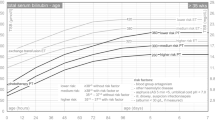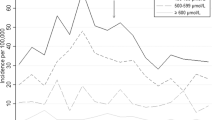Abstract
A review of the literature demonstrates that severe total hyperbilirubinemia (total serum bilirubin ≥ 20 mg/dL [340 µmol/L]) in some cholestatic term (≥37 weeks) and late-preterm (≥340/7–366/7 weeks) gestation neonates poses a risk for bilirubin-induced brain damage. When the direct bilirubin fraction is <50% of the total serum bilirubin this risk is associated with the total serum bilirubin alone and treatment decisions should be based on the total serum bilirubin. On the other hand, there are limited data on the risk of bilirubin-induced brain damage in the neonate with severe total hyperbilirubinemia and a direct bilirubin fraction that is equal to or exceeds 50% of the total serum bilirubin. When this rare combination occurs, efforts to keep the indirect bilirubin fraction from reaching severe levels might, nevertheless, be prudent.
This is a preview of subscription content, access via your institution
Access options
Subscribe to this journal
Receive 12 print issues and online access
$259.00 per year
only $21.58 per issue
Buy this article
- Purchase on Springer Link
- Instant access to full article PDF
Prices may be subject to local taxes which are calculated during checkout
Similar content being viewed by others
References
Maisels MJ. The clinical approach to the jaundiced newborn. In: Maisels MJ, Watchko JF, editors. Neonatal jaundice. Harwood Academic Publishers: Amsterdam; 2000. p. 162–3.
Claireaux AE, Cole PG, Lathe GH. Icterus of the brain in the newborn. Lancet. 1953;265:1226–30.
Diamond I, Schmid R. Experimental bilirubin encephalopathy. The mode of entry of bilirubin-14C into the central nervous system. J Clin Invest. 1966;45:678–88.
Schmid R. The role of protein interaction in the tissue uptake of bilirubin. In: Bouchier IAD, Billing BH, editors. Bilirubin metabolism. F.A. Davis Company: Philadelphia; 1967. p. 147–57.
McDonagh AF. Bile pigments: bilatrienes and 5,15-biladienes. In: Dolphin D, editor. The porphyrins. Volume VI. Biochemistry, Part A. Academic Press: New York; 1979. p. 379–84.
Stoll BJ, Kliegman RM. Digestive system disorders. In: Behrman RE, Kliegman RM, Jenson HB, editors. Nelson textbook of pediatrics. 17th Edition. Saunders: Philadelphia, 2004, 597.
Barrett CT. Hemolytic disease of the newly born infant. In: Gellis SS, Kagan BM, editors. Current pediatric therapy 9. Saunders: Philadelphia; 1980. p. 735–38.
Hsai DY, Patterson P, Allen FH Jr., Diamond LK, Gellis S. Prolonged obstructive jaundice in infancy. I. General survey of 156 cases. Pediatrics. 1952;10:243–52.
Dunn PM. Obstructive jaundice and haemolytic disease of the newborn. Arch Dis Child. 1963;38:54–61.
Polacek K. Risk of kernicterus in newborn infants with a high level of conjugated bilirubin. Acta Paediatr Scand. 1966;55:401–4.
Grobler JM, Mercer MJ. Kernicterus associated with elevated predominantly direct reacting bilirubin. S Afr Med J. 1997;87:1146.
Maisels MJ, Baltz RD, Bhutani VK, Newman TB, Palmer H, Rosenfeld W, et al. Management of hyperbilirubinemia in the newborn infant 35 or more weeks of gestation. Pediatrics. 2004;114:297–316.
Kaplan M, Merlob P, Regev R. Israeli guidelines for management of neonatal hyperbilirubinemia and prevention of kernicterus. J Perinatol. 2008;28:389–97.
Atkinson M, Budge H. Review of the NICE guidance on neonatal jaundice. Arch Dis Child Educ Pract Ed. 2011;96:136–40.
Bratlid D, Nakstad B, Hansen TWR. National guidelines for treatment of jaundice in the newborn. Acta Paediatr. 2011;100:499–505.
Bhutani VK, Johnson LH, Maisels MJ, Newman TB, Phibbs C, Stark AR, et al. Kernicterus: epidemiological strategies for its prevention through systems-based approaches. J Perinatol. 2004;24:650–62.
Davis AR, Rosenthal P, Escobar GJ, Newman TB. Interpreting conjugated bilirubin levels in newborns. J Pediatr. 2011;158:562–.e561.
Harpavat S, Garcia-Prats JA, Anaya C, Brandt ML, Lupo PJ, Finegold MJ, et al. Diagnostic yield of newborn screening for biliary atresia using direct or conjugated bilirubin measurements. JAMA. 2020;323:1141–50.
Greene DN, Liang J, Holmes DT, Resch A, Lorey TS. Neonatal total bilirubin measurements: Still room for harmonization. Clin Biochem. 2014;47:1112–5.
Oppe TE, Valaes T. Obstructive jaundice and haemolytic disease of the newborn. Lancet. 1959;1:536–9.
Dunn PM. Obstructive jaundice, liver damage and Rh haemolytic disease of the newborn. Jew Meml Hospital Bull. 1965;10:94–124.
Stempfel R, Broman B, Escardo FE, Zetterstrom R. Obstructive jaundice complicating hemolytic disease of the newborn. Pediatrics. 1956;17:471–81.
Bowman JM. Neonatal management. In: Queenan JT, editor. Modern management of the Rh problem. Harper & Row: New York; 1977. p. 200–39.
Bowman JM. Alloimmune hemolytic disease of the neonate. In: Stockman JA, Pochedly C, editors. Developmental and neonatal hematology. Raven Press: New York; 1988. p. 223–48.
Zuelzer WW, Brown AK. Neonatal jaundice. A review. Am J Dis Child. 1961;101:87–127.
Smits-Wintjens VEHJ, Rath MEA, Lindenburg ITM, Oepkes D, van Zwet EW, Walther FJ, et al. Cholestasis in neonates with red cell alloimmune hemolytic disease: incidence, risk factors and outcome. Neonatology. 2012;101:306–10.
Allgood C, Bolisetty S. Severe conjugated hyperbilirubinemia and neonatal hemolysis. Int J Clin Pract. 2006;60:1513–4.
McAdams RM, Dotzler SA, Winter LW, Kerecman JD. Severe hemolytic disease of the newborn from anti-e. J Perinatol. 2008;28:230–2.
Usman AS, Mustaffa R, Ramli N, Diggi SA. Hemolytic disease of the fetus and newborn caused by anti-E. Asian J Transfus Sci. 2013;7:84–85.
Smith G, Knott P, Rissik J, de la Fuente J, Win N. Anti-U and haemolytic disease of the fetus and newborn. Br J Obstet Gynaecol. 1998;105:1318–21.
Raju TNK, Javed DIS. Fetal intrahepatic cholestasis secondary to BO hemolytic disease. J Nat Med Assoc. 1981;73:747–49.
Najak Z, Kanto WP Jr., Carrillo PJ. ABO hemolytic disease of the newborn associated with direct reacting hyperbilirubinemia. J Med Assoc Ga 1982;71:267–71.
Sivan Y, Merlob P, Nutman J, Reisner SH. Direct hyperbilirubinemia complicating ABO haemolytic disease of the newborn. Clin Pediatr. 1983;22:537–8.
Zonneveld R, van der Meer-Kapelle L, Sylva M, Brand A, Zijstra M, Schonewille H. Severe fetal hemolysis and cholestasis due to high titer maternal IgG anti-A antibodies. Pediatrics. 2019;143:e20182859.
Kordes U, Richter A, Santer R, Schafer H, Singer D, Sonntag J, et al. Neonatal cholestasis and glucose-6-P-dehydrogenase deficiency. Pediatr Blood Cancer. 2010;54:758–60.
Raphael MF, Van Wijk R, Schweizer JJ, Schouten-van Meeteren NAY, Kindermann A, van Solinge WW, et al. Pyruvate kinase deficiency associated with severe liver dysfunction in the newborn. Am J Hematol. 2007;82:1025–8.
Olivier F, Wieckowska A, Piedboeuf B, Alvarez F. Cholestasis and hepatic failure in a neonate: a case report of severe pyruvate kinase deficiency. Pediatrics. 2015;136:e1366–e1368.
Lane E, Murray KF. Neonatal cholestasis. Pediatr Clin N Am. 2017;64:621–39.
Hamilton JR, Sass-Kortsak A. Jaundice associated with severe bacterial infection in young infants. J Pediatr. 1963;63:121–32.
Bech LF, Donneborg ML, Lund AM, Ebbesen F. Extreme neonatal hyperbilirubinemia, acute bilirubin encephalopathy, and kernicterus spectrum disorder in children with galactosemia. Pediatr Res. 2018;84:228–32.
Ryan TD, Dimmitt RA, Tubbs RS, Roberts OA, Choi H, Loukas M, et al. Contribution of surgical evacuation of a large subgaleal hematoma to the resolution of severe conjugated hyperbilirubinemia in a neonate. J Neurosurg. 2007;106:131–33.
Singh A, Sachan R. Congenital cytomegalovirus infection presenting as severe conjugated hyperbilirubinemia in the first day of life. Int J Pediatr Res. 2018;4:035.
Copeland KC, Franks RC, Ramamurthy R. Neonatal hyperbilirubinemia and hypoglycemia in congenital hypopituitarism. Clin Pediatr. 1981;20:523–26.
Drop SLS, Colle E, Guyda HJ. Hyperbilirubinemia and idiopathic hypopituitarism in the newborn period. Acta Paediatr Scand. 1979;68:277–80.
Oh KS, Bahmad HF, Brathwaite C, Sanchez AC, Recine M. Neonatal acute liver failure with pulmonary yellow hyaline membrane and kernicterus. Autops Case Rep. 2021;11:e2021268.
Romero Lopez MM, Pryce C, Maisels MJ. A newborn with a blueberry muffin rash, hepatosplenomegaly, thrombocytopenia and severe cholestatic Jaundice at birth. Clin Pediatr Oa. 2017;2:121.
Makkar A, Mahmood B, Watchko JF. Severe hyperbilirubinemia in neonates during ECMO: important role of hemolysis. J Invest Med. 2016;64:612.
Perlman JM, Volpe JJ. Bilirubin. In: Volpe JJ, Inder TI, Barras DT, de Vries LS, du Plessis AJ, Neil JJ, Perlman JM, editors. Volpe’s neurology of the newborn. 6th edition. Elsevier: Philadelphia; 2018. p. 730-62.
Boon WH. Kernicterus not associated with haemolytic disease. Arch Dis Child. 1957;32:85–90.
Valaes T, Fessas P, Doxiadis SA. Kernicterus in full-term infants without isoimmunization (4 cases). Proc R Soc Med. 1961;54:331–3.
Doxiadis SA, Valaes T. The clinical picture of glucose 6-phosphate dehydrogenase deficiency in early infancy. Arch Dis Child. 1964;39:545–53.
Naiman JL, Kosoy MH. Red cell glucose-6-phosphate dehydrogenase deficiency—a newly recognized cause of neonatal jaundice and kernicterus in Canada. Can Med Assoc J. 1964;91:1243–9.
Johnston WH, Angara V, Baumal R, Hawke WA, Johnson RH, Keet S, et al. Erythroblastosis fetalis and hyperbilirubinemia. A five-year follow-up with neurological, psychological, and audiological evaluation. Pediatrics. 1967;39:88–92.
Walker W, Ellis MI, Ellis E, Curry A, Savage RD, Sawyer R. A follow-up study of survivors of Rh-haemolytic disease. Dev Med Child Neurol. 1974;16:592–611.
Clark CF, Torii S, Hamamoto Y, Kaito H. The “bronze baby” syndrome: postmortem data. J Pediatr. 1976;88:461–64.
Johnson L. Hyperbilirubinemia in the term infant: when to worry, when to treat. NY State J Med. 1991;91:483–9.
Penn AA, Enzmann DR, Hahn JS, Stevenson DK. Kernicterus in a full term infant. Pediatrics. 1994;93:1003–6.
Maisels MJ, Newman TB. Kernicterus in otherwise healthy, breast-fed term newborns. Pediatrics. 1995;96:730–3.
Washington EC, Ector W, Abboud M, Ohning B, Holden K. Hemolytic jaundice due to G6PD deficiency causing kernicterus in a female newborn. South Med J. 1995;88:776–79.
Ebbesen F. Recurrence of kernicterus in term and near-term infants in Denmark. Acta Paediatr. 2000;89:1213–7.
Bertini G, Dani C, Fonda C, Zorzi C, Rubaltelli FF. Bronze baby syndrome and the risk of kernicterus. Acta Paediatr. 2005;94:968–71.
Castilho TR, Vargas MS, Pinsuti A, Rocha MA, D’Bertagnon JR. Bilirubin encephalopathy due to Rh incompatibility. Einstein. 2011;9:220–3.
Iskander I, Gamaleldin R, El Houchi S, El Shenawy A, Seoud I, El Gharbawi, et al. Serum bilirubin and bilirubin/albumin ratio as predictors of bilirubin encephalopathy. Pediatrics. 2014;134:e1330–9.
Sahoo T, Thukral A, Agarwal R, Sankar MJ. Galactosemia: an unusual cause of chronic bilirubin encephalopathy. BMJ Case Rep. 2015;bcr-2014-206852.
Oh KS, Bahmad HF, Brathwaite C, Sanchez AC, Recine M. Neonatal acute liver failure with pulmonary yellow hyaline membrane and kernicterus. Autops Case Rep. 2021;11:e2021268.
Hsai DY, Walker FA. Variability in the clinical manifestations of galactosemia. J Pediatr. 1961;59:872–83.
Hertel PM, Hawthorne K, Kim S, Finegold MJ, Shneider BL, Squires JE, et al. Presentation and outcomes of infants with idiopathic cholestasis: a multi-center prospective study. J Pediatr Gastroenterol Nutr. 2021; Aug 2, online ahead of print.
Sundaram SS, Alonso EM, Narkewicz MR, Zhang S, Squires RH, Pediatric Acute Liver Failure Study Group. Characterization and outcomes of young infants with acute liver failure. J Pediatr. 2011;159:813–8.
Peinado-Acevedo JS, Chacon-Valenzuela E, Rodriguez-Moncada LL. Tan baby syndrome, an unpredictable complication of phototherapy. Biomedica. 2018;38:15–18.
A-Kadar HH, Balistreri WF. Unconjugated hyperbilirubinemia. In: Burg FD, Ingelfinger JR, Wald ER, editors. Current pediatric therapy, 14th Edition, WB Saunders: Philadelphia; 1993. p. 218–9.
Porter MI, Dennis BL. Hyperbilirubinemia in the term newborn. Am Fam Physician. 2002;65:599–606.
Kopelman AE, Brown RS, Odell GB. The “bronze” baby syndrome: a complication of phototherapy. J Pediatr. 1972;81:466–72.
Rubaltelli FF, Jori G, Reddi E. Bronze baby syndrome: a new porphyrin-related disorder. Pediatr Res. 1983;17:327–30.
Rubaltelli FF, Da Riol R, D’Amore E, Jori G. The bronze baby syndrome: evidence of increased tissue concentration of copper porphyrins. Acta Paediatr. 1996;85:381–4.
McDonagh AF. Bilirubin, copper-porphyrins, and the bronze-baby syndrome. J Pediatr. 2011;158:160–4.
Meisel P, Jahrig D, Theel L, Ordt AM, Jahrig K. The bronze baby syndrome: consequence of impaired excretion of photobilirubin? Photobiochem Photobiophys. 1982;3:345–52.
Onishi S, Itoh S, Isobe K, Togari H, Kitoh H, Nishimura Y. Mechanism of development of bronze baby syndrome in neonates treated with phototherapy. Pediatrics. 1982;69:273–6.
Itoh S, Okada H, Kuboi T, Kusaka T. Phototherapy for neonatal hyperbilirubinemia. Pediatr Int. 2017;59:959–66.
Ebbesen F. Low reserve albumin for binding of bilirubin in neonates with deficiency of bilirubin excretion and bronze baby syndrome. Acta Paediatr Scand. 1982;71:415–20.
Tan KL, Jacob E. The bronze baby syndrome. Acta Paediatr Scand. 1982;71:409–14.
McDonagh AF. Controversies in bilirubin biochemistry and their clinical relevance. Semin Fetal Neo Med. 2010;15:141–47.
Schmid R. Direct-reacting bilirubin, bilirubin glucuronide, in serum, bile, and urine. Science. 1956;124:76–77.
Ullrich D, Tischler T, Sieg A, Fevery J. Renal clearance of bilirubin conjugates in newborns of different gestational age. Eur J Pediatr. 1993;152:837–39.
Priolisi A. Does conjugated bilirubin displace unconjugated bilirubin from albumin? Arch Dis Child. 1976;51:990–1.
Venigalla S, Gourley GR. Neonatal cholestasis. Semin Perinatol. 2004;28:348–55.
Nassabeh-Montazami S. Phototherapy. In: MacDonald MG, Ramasethu J, Rais-Bahrami K, editors. Atlas of procedures in neonatology. Lippincott Williams & Wilkens: Philadelphia; 2013. p. 357–60.
Maisels MJ, Stevenson DK, Watchko JF, McDonagh AF. Phototherapy and other treatments. In: Stevenson DK, Maisels MJ, Watchko JF, editors. Care of the jaundiced neonate. McGraw-Hill: New York; 2012. p. 195–227.
Kaplan M, Muraca M, Hammerman C, Vilei MT, Rubaltelli FF. Unconjugated and conjugated bilirubin pigments during perinatal development. V. Effect of phototherapy on serum conjugated bilirubin in hyperbilirubinemic neonates. Biol Neonate. 1998;73:155–60.
Maisels MJ, Bhutani VK, Bogen D, Newman TB, Stark AR, Watchko JF. Hyperbilirubinemia in the newborn infant > or =35 weeks’ gestation: an update with clarifications. Pediatrics. 2009;124:1193–8.
American Academy of Pediatrics. Steering Committee on Quality Improvement and Management. Classifying recommendations for clinical practice guidelines. Pediatrics. 2004;114:874–7.
Newman TB. Universal bilirubin screening, guidelines, and evidence. Pediatrics. 2009;124:1199–202.
Christensen RD, Yaish HM. Hemolytic disorders causing severe neonatal hyperbilirubinemia. Clin Perinatol. 2015;42:515–27.
Acknowledgements
The authors gratefully acknowledge the generous assistance of Carrie Everstine of the Magee-Womens Hospital medical library.
Author information
Authors and Affiliations
Contributions
JF Watchko conceptualized the review, carried out the literature search, drafted the initial manuscript, and reviewed and revised the manuscript. MJ Maisels critically reviewed the manuscript for important intellectual content, played an important role in interpreting the literature findings, and reviewed and revised the manuscript. Both authors approved the final manuscript as submitted and agree to be accountable for all aspects of the work.
Corresponding author
Ethics declarations
Competing interests
Both authors report serving as a consultant in medico-legal cases related to kernicterus.
Additional information
Publisher’s note Springer Nature remains neutral with regard to jurisdictional claims in published maps and institutional affiliations.
Rights and permissions
About this article
Cite this article
Watchko, J.F., Maisels, M.J. Management of severe hyperbilirubinemia in the cholestatic neonate: a review and an approach. J Perinatol 42, 695–701 (2022). https://doi.org/10.1038/s41372-022-01330-8
Received:
Revised:
Accepted:
Published:
Issue Date:
DOI: https://doi.org/10.1038/s41372-022-01330-8



